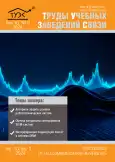Оценка визуальных интерфейсов систем управления информационной безопасностью
- Авторы: Чечулин А.А.1,2
-
Учреждения:
- Санкт-Петербургский Федеральный исследовательский центр Российской академии наук
- Санкт-Петербургский государственный университет телекоммуникаций им. проф. М. А. Бонч-Бруевича
- Выпуск: Том 10, № 3 (2024)
- Страницы: 116-126
- Раздел: ИНФОРМАЦИОННЫЕ ТЕХНОЛОГИИ И ТЕЛЕКОММУНИКАЦИИ
- URL: https://journals.rcsi.science/1813-324X/article/view/259517
- EDN: https://elibrary.ru/HZWDEV
- ID: 259517
Цитировать
Полный текст
Аннотация
Об авторах
А. А. Чечулин
Санкт-Петербургский Федеральный исследовательский центр Российской академии наук; Санкт-Петербургский государственный университет телекоммуникаций им. проф. М. А. Бонч-Бруевича
Email: chechulin.aa@sut.ru
ORCID iD: 0000-0001-7056-6972
SPIN-код: 1632-0938
Список литературы
- Левшун Д.С., Гайфулина Д.А., Чечулин А.А., Котенко И.В. Проблемные вопросы информационной безопасности киберфизических систем // Информатика и автоматизация. 2020. № 5(19). С. 1050‒1088. doi: 10.15622/ia.2020.19.5.6. EDN:NIWASO
- Gan M., Lyu M. Investigation on Visual Communication Design Based on Information Systems // Proceedings of the 2nd International Conference on Data Analytics, Computing and Artificial Intelligence (ICDACAI, Zakopane, Poland, 17‒19 October 2023). IEEE, 2023. PP. 720‒725. doi: 10.1109/ICDACAI59742.2023.00143
- Kolomeec M.V., Gonzalez-Granadillo G., Doynikova E.V., Chechulin A.A., Kotenko I.V., Debar H. Choosing Models for Security Metrics Visualization // Proceedings of the 7th International Conference on Mathematical Methods, Models, and Architectures for Computer Network Security (MMM-ACNS 2017, Warsaw, Poland, 28‒30 August 2017). Lecture Notes in Computer Science. Cham: Springer, 2017. Vol. 10446. PP. 75‒87. doi: 10.1007/978-3-319-65127-9_7
- Вострых А.В. Метод и алгоритмы многокритериальной оценки графических пользовательских интерфейсов программных продуктов МЧС России // Национальная безопасность и стратегическое планирование. 2022. Nº 4(40). С. 57‒64. doi: 10.37468/2307-1400-2023-2022-4-57-64. EDN:GCHUOC
- Сервис Feng-GUI для оценки качества графического интерфейса пользователя // Feng-Gui. URL: http://www.feng-gui.com (Accessed 06.05.2024)
- Scott B. The Art of UI Prototyping. 2006. URL: https://msdn.microsoft.com/en-us/library/ms993294.aspx (Accessed 06.05.2024)
- Sauro J. 10 Benchmarks for User Experience Metrics. 2012. URL: https://measuringu.com/ux-benchmarks (Accessed 06.05.2024)
- System Usability Scale (SUS) // Usability.gov. URL: http://www.usability.gov/how-to-and-tools/methods/system-usability-scale.html (Accessed 06.05.2024)
- Sawyer P., Flanders A., Wixon D. Making a Difference – The Impact of Inspections // Proceedings of the SIGCHI Conference on Human Factors in Computing Systems (Vancouver, Canada, 13‒18 April 1996). New York: ACM Press, 1996. PP. 376‒382. doi: 10.1145/238386.238579
- Medlock M.C., Wixon D., Terrano M., Romero R.L., Fulton B. Using the RITE method to improve products; a definition and a case study. URL: https://citeseerx.ist.psu.edu/document?repid=rep1&type=pdf&doi=5340ef8a91900840263a4036b0433a389b7097b2 (Accessed 06.05.2024)
- Novikova E., Kotenko I., Fedotov E. Interactive Multi-View Visualization for Fraud Detection in Mobile Money Transfer Services // International Journal of Mobile Computing and Multimedia Communications. 2014. Vol. 6. Iss. 4. PP. 73‒97. doi: 10.4018/IJMCMC.2014100105
- Stickel C., Ebner M., Holzinger A. The XAOS Metric – Understanding Visual Complexity as Measure of Usability // Proceedings of the 6th Symposium of the Workgroup Human-Computer Interaction and Usability Engineering (USAB 2010, Klagenfurt, Austria, 4‒5 November 2010). Lecture Notes in Computer Science. Berlin, Heidelberg: Springer, 2009. Vol. 6389. PP. 278‒290. doi: 10.1007/978-3-642-16607-5_18
- Vanderdonckt J. Automated evaluation of graphical user interface metrics. Louvain-la-Neuve: Année académique, 2010‒2011.
- Card S., Moran T.P., Newell A. The Psychology of Human-Computer Interaction. Hillsdale: Lawrence Erlbaum Associates, 1983. 469 p.
- Card S.K., Moran T.P., Newell A. The Key Stroke-Level Model for User Performance Time with Interactive Systems // Communications of the ACM. 1980. Vol. 23. Iss. 7. PP. 396‒410. doi: 10.1145/358886.358895
Дополнительные файлы






